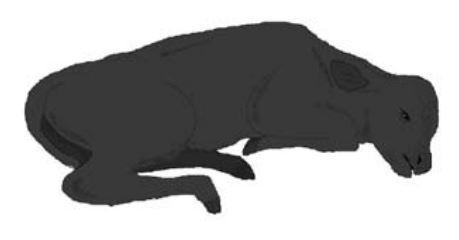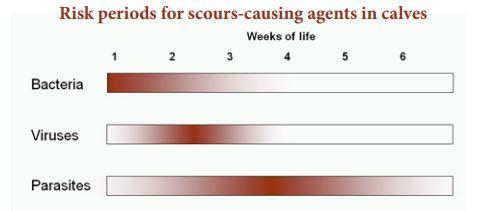What is scours?
Scours is the common name for diarrhea in calves. Diarrhea is a disease of the digestive system characterized by watery feces and increased frequency of bowel movements.
The high water content in the feces results in water loss from the body (dehydration). Along with water, the body loses electrolytes, which are needed to maintain all bodily functions. The loss of electrolytes causes a condition called metabolic acidosis, which will kill the calf if it is not corrected promptly (in less than two days).
Which animals are affected?
Diarrhea commonly affects newborn calves. Young calves likely are more prone to diarrhea because of their liquid diet (milk), the higher water content in their bodies (compared to adult cattle) and their susceptibility to certain age-specific infectious diseases of the intestinal tract.
What are the signs?
- Loose stools — Dirty tail.
- Dehydration — Sunken eyes, slow skin tent (more than two seconds).
- Depression — Head down, ears down, not willing to stand for a long time.
- Weakness — Easier to catch, unstable when walking.
- Fever or, in late stages of disease, cold extremities (ears and legs).
- Loss of suckle reflex — Indicates severe disease.
- Fast or slow breathing — An animal with metabolic acidosis will breathe rapidly to reduce carbon dioxide in the blood; this partially corrects the acidosis. This rapid breathing is often confused with signs of pneumonia. During the final stages of the disease, closer to death, the animal will breathe more slowly and deeply.
Estimated base deficit* according to clinical signs observed in diarrheic calves.
*Base deficit explains the amount of bicarbonate necessary to restore blood pH to normal (pH=7.4).
Modified from Naylor, J.M. A retrospective study of the relationship between clinical signs and severity of acidosis in diarrheic calves. 1989. Can Vet J. 30:577–580.
What causes it?
Any type of digestive upset can cause diarrhea in calves.
Infectious agents (bacteria and viruses) can attack the lining of the gut, causing water loss through the damaged wall. Several infectious agents have been shown to cause diarrhea in unweaned calves.
- Bacteria, such as Escherichia coli and Salmonella, are common in newborn calves (usually younger than 2 weeks old), although Salmonella can affect cattle of any age.
- Viruses, such as Rotavirus and Coronavirus, commonly affect calves in their first few weeks of life (usually 1 to 3 weeks).
- Parasites, namely Coccidia and Cryptosporidium parvum, can cause diarrhea in young calves.
Calves can be infected with multiple infectious agents at the same time — for example, Rotavirus, Coronavirus, and Cryptosporidia. Some of these organisms can also cause disease in people working with calves.
Is it a problem?
According to a national survey on beef cattle health (NAHMS 19971), diarrhea is the disease with the highest morbidity among preweaned beef calves. About 2.4% of calves younger than 3 weeks old were reported to suffer from diarrhea.
This figure likely understates the problem because large producers cannot monitor calves closely enough to detect all cases of diarrhea. According to the same report, about 1.7% of unweaned calves more than 3 weeks old suffer diarrhea.
Thus, younger calves are at higher risk of having diarrhea. Keeping records of the incidence of diarrhea on your ranch is an essential tool to determine whether it is a problem on your operation.
How to treat?
The best treatment is prompt and complete.
Treatment should be aimed at correcting the clinical signs:
- The most important treatment is to correct dehydration and metabolic acidosis. If they are not corrected, the calf will die. Both are treated simultaneously by administering electrolytes.
- Oral electrolytes can keep acidosis under control in a calf that is strong enough to stand and suckle.
- When the calf is down, oral electrolytes are not enough, and intravenous therapy is needed. Intravenous fluids are necessary to correct acidosis and dehydration in calves at this stage of the disease.
- Systemic (injectable) antimicrobials will help eliminate bacteria but do not work against viruses.
- Keep feeding the calf; milk is its only source of energy. If body cells don’t get energy, the calf will die. If you cannot feed milk, use a good milk replacer. If the calf does not suckle, you will need to feed milk via a tube or administer intravenous therapy.
- Provide supportive care: Protect sick calves from the cold (minimum 50°F), wind and rain.
- Many products are sold for supportive care of calves with diarrhea. These include gut protectants such as kaolin and pectin, toxin adsorbents such as activated charcoal, and probiotics. Efficacy of these products is debated. They are beneficial only when the three main elements of treatment have been addressed: correcting dehydration and acidosis, treating infections and providing energy.
Not all products — whether electrolytes, antimicrobials, or milk replacers — work the same. Ask your veterinarian which products are the best for your situation.
Administer all products according to manufacturer instructions (read the label). Do not mix electrolytes with milk; they may interfere with curd formation and cause diarrhea due to digestive upset, worsening the problem.
How to prevent?
- Ensure that all calves get colostrum within the first six hours. If they don’t nurse from the cow, provide colostrum via a bottle or tube. Colostrum is a calf ’s most important defense mechanism until its own immune system is capable of providing protection.
- The best prevention is to reduce pathogen exposure by providing a clean environment, beginning at birth. The calving area should be clean and uncrowded. No amount of colostrum or treatment can make up for excessive exposure to bacteria and viruses in the environment. Change calving areas several times during the calving season to minimize exposure to increasing pathogen load.
- Provide a balanced mineral program to the mother cows prior to and after calving to ensure that the cow has the foundation for normal electrolyte balance and milk production.
- Some organisms, such as Salmonella, Rotavirus, and Coronavirus, can be fought by vaccinating cows during the final trimester of pregnancy. Vaccination will cause the cow to produce immunoglobulins (defense proteins) that specifically attack these organisms. These specific proteins, along with nonspecific immunoglobulins normally produced in the body, will be secreted into the colostrum and reach the calf when it nurses.




